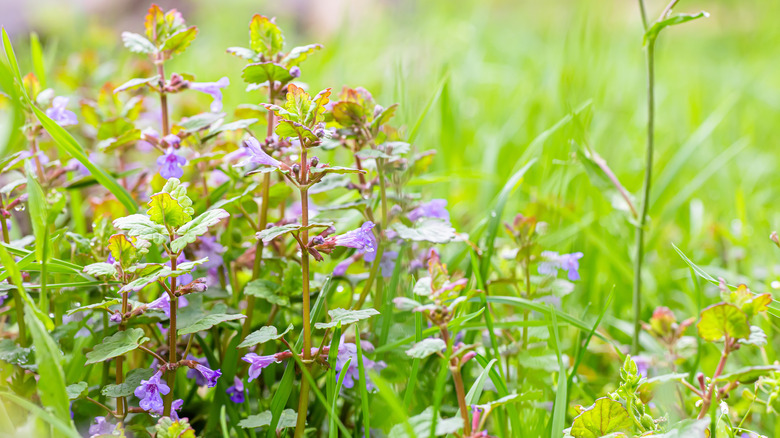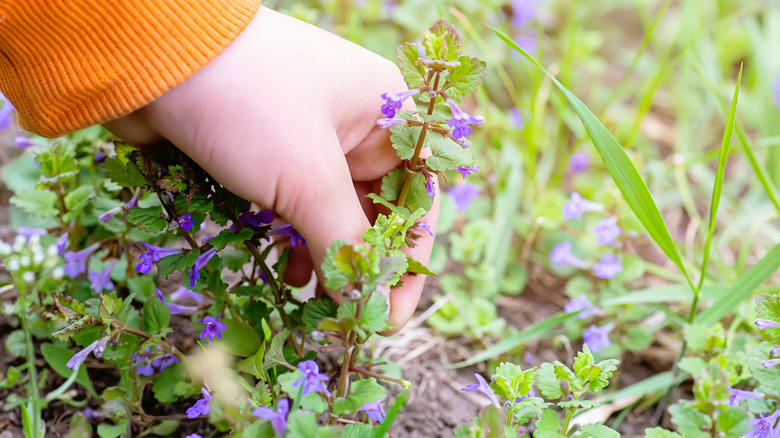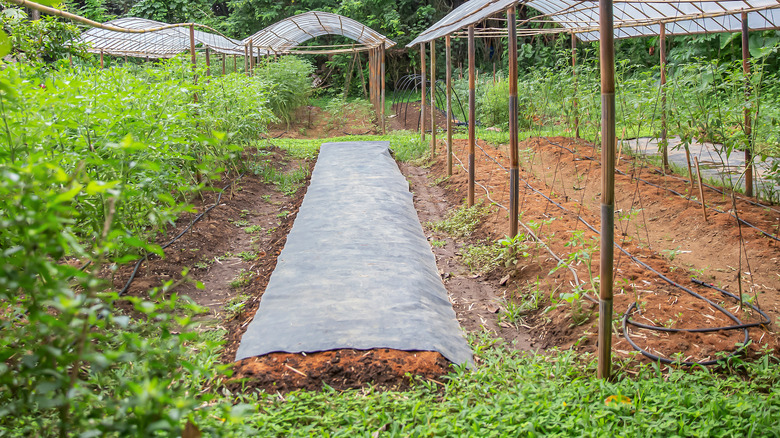The Easy Trick That Wipes Out Creeping Charlie Weed So It Doesn't Take Over
Do you have some type of evergreen, creeping-like plant growing in a shaded and moist area of your grass? It typically has bright green leaves with a kidney-like shape and, during the spring months, tiny, purple flowers. If so, you may have creeping Charlie (Glechoma hederacea) in your yard. This is a pesky type of weed that can overtake your yard if left to its own devices. There are a few tricks you can use to get rid of it, including plucking it out by hand, but the best route may be starving the plant of sunlight to keep it from growing.
As a ground ivy, creeping Charlie can seem like it's on a mission to spread across your entire lawn, and as it does, it can pull valuable nutrients from the soil and make it much harder for grass to grow. It grows well in just about any environment and adapts to conditions fairly easily. While it's not toxic to people or pets and will help encourage pollinators to visit your yard (a great way to get bees in to help support your vegetable garden), it's all about control.
You'll find that while those soft, funnel-shaped flowers are beautiful, without management, this fast-spreading weed can damage your lawn over time. As an invasive species, you'll want to learn how to rid your entire yard of creeping Charlie before it decimates the grass. Starving it of sunlight is the trick you need.
Pulling creeping Charlie helps, but it's not enough
If you've just discovered a small amount of creeping Charlie under a tree or perhaps near the newly planted shrubs, the best and easiest way to get rid of it is to pull it out of the ground. Keep a trash bag as close as possible to catch any seeds, and then pull the weed from the ground up, removing all of the vines, leaves, and stems. Avoid putting these into your compost bin since that can simply encourage them to come back once you use the compost.
The problem is, unless you have just a small patch, you're not likely going to want to spend your days sitting on the lawn plucking out one vine after the other to eradicate it. Another option then is to cut off its source of energy: the sun. While creeping Charlie does well in shaded areas (and really is willing to spread just about anywhere because of how adaptable it is), this can be a tricky process. If it's very invasive, the best step is to tarp the entire lawn or cover it with cardboard, eliminating all sunlight.
Denying them access to light will also kill any grass or other plants that are covered. Leave the tarp or cardboard in place for at least a week, then determine if the plants are brown and dying. If so, you can remove them, put them in a trash bag, and reseed your lawn. Just be sure to reseed at the proper time for best results.
Additional tips that can work to bring creeping Charlie under control
If pulling it by hand and killing off your lawn fully aren't really the solutions you're looking for, there are a few other strategies that can support the removal and control of creeping Charlie. Unless you're against doing so, consider the application of a postemergence broadleaf herbicide. Follow the manufacturer's directions on how to apply it to the weed. Look for a product that contains triclopyr, which is often found in weed killers. It can be used on your lawn, but avoid using it in the garden since many vegetables and flowers could likewise be killed.
Another option is to use the sun against the plant. A process called solarization can help reduce grass and weeds in an otherwise difficult-to-treat area. This method, which includes placing a clear plastic sheet over the ground in the spring or summer, will cause the plants to die as the soil temperature becomes too high to maintain growth.
There are some natural solutions that may offer some help, too, such as using vinegar to get rid of invasive creeping Charlie. Applied directly to the leaves, it can harm the plant enough to lead to its death. Good lawn care management can also help, including keeping the grass cut and ensuring that shaded areas have good drainage so they dry out fully. This creates a more challenging environment for the weed to grow in. If you need to reseed the area, choose options like fine fescues that are better suited for shaded areas.


